 Back to Blogs
Back to Blogs
Content Creation Strategy – Mobile Takes It Beyond SEO
Over fifty years ago Marshall McLuhan suggested that “the medium is the message” in his book Understanding Media.
This is especially true now when comparing media such as a mouse operated computer screen to a tablet’s touch interface to a smart phone’s surface… which have indeed become “The Extensions of Man” as the book’s prophetic subtitle suggested.
Ironically, many years later, skeuomorphic design unsuccessfully attempted to counteract the power of the new rising medium (the flat mobile device screen) by borrowing visual cues from old-timey physical world products. I’m delighted to note that the medium won, as McLuhan would have predicted, and skeuomorphic design is now buried in the ash-heap of history (Sir Jonathan Ive and Craig Federighi were the lead pallbearers at Apple).
Continuing to borrow from McLuhan, if the “content of any medium is always another medium”, what’s the right approach for a content creation strategy that will not lead us into the ash-heap of history?
Background
One answer that many in the recent past wrongly took to be “the answer” is to primarily optimize content strategy for Search Engine Optimization (SEO). In the hospitality arena, this may well have worked some time back, when being at the top of the first page of Search Engine Results Pages (SERPs) was the only and holy grail.
Before all my fellow SEO-lovers break into rashes, let’s stipulate that SEO is extraordinarily important. And furthermore let’s also stipulate that it’s not easy. We all hear from people that could either sell us a bridge in Brooklyn or bogus work that “guarantees” position number 1 in SERPs. One of my past clients fell for such a ploy and did see a temporary rankings increase. It wasn’t until penalties kicked in and they had to call me to direct the cleanup that it became clear that the SEO “experts” had contracted link farms in third world countries which wrote a bunch articles about “sex in <enter destination the client cared about>.”
On a side note, it says something about humans that people search for “sex” thirteen times more often than they search for “god”. Closer to home, our industry should note that while ten years ago people cared about “hotels” about five times more than about “god”, more recently “hotels” and “god” are running nearly even. So the next time you need a rank boost for your hotel in Peoria, just create a link farm about “sex in Peoria” and then search for “god” so you can pray that Google won’t catch you too quickly.
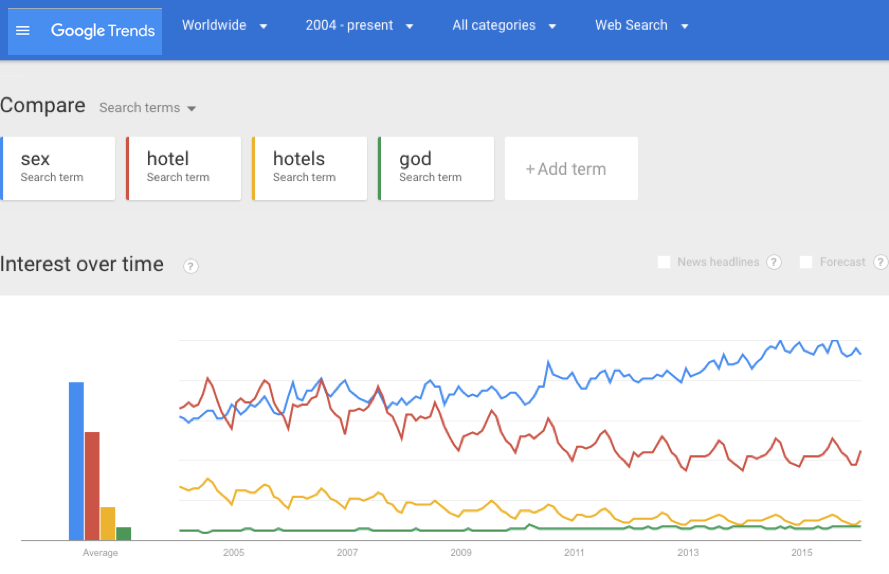
Obviously, the actual hard work to restructure Web properties and pages within properties to yield the maximal flow of ranking influence is legitimate, just much harder to do. So much so that I may well have more to say about it in a subsequent column. But in may ways this is old news: of course you should get all your technical SEO factors right, and of course you should tune your content to support not just a persuasive marketing message but also whatever you want that content to rank for.
Setting “sex” and “god” aside for moment, there appears to be a long term decline in searches for “hotel” / “hotels” that may be worth exploring in greater detail.
Does this mean that as people get more interested in bars, they become less interested in hotels to sleep in? Something else may be at play here, and that something is the shifting of usage patterns as the favored medium is increasingly mobile.
Because it’s so important, let’s restate this hypothesis once more: the medium is influencing the dialogue taking place through it. New possibilities, mediated by an evolving interface, are leading to new entry points and to new content.
Perhaps at some point long ago the primary use case with respect to hotels might be as shown nearby in the traditional search results. That was all very good in times past. But now you might instead see a map driven search (whether location aware or driven remotely).
In the age of smaller mobile screens, the very first few words visible on the screen without swiping become incredibly critical at every step of the hospitality customer journey. Among other things, it is in order to get those first few words to the right person on the right viewport at the right time that a content creation strategy is so critical, and especially so in the mobile-first world we live in.
Examples of Mobile Content Impact
So why does mobility require an intentional, deliberate content strategy, even to the point of supplanting SEO concerns if and when there’s a conflict?
On a more expansive medium such as a desktop screen there’s a lot of room to be lazy about content and sketchy copy writing. For example, you might see the lead description for a hotel go something like this:
“It is not everyday that you are able to find a jewel like this hotel. With a great history dating back to 1926, we have a unique property, with the simultaneous benefit of both historical architecture and hip bars with a modern atmosphere.”
I don’t know about you, but I fell asleep writing the passage, so I can only imagine how annoying it must be to try to read it in tiny font on a smartphone. Note that Marriott, the brand ranking highest on the above search, had much better copy in its SERP snippet:
“Hip and Historic in downtown Peoria Illinois…”
Sadly, for mobile searches Marriott’s content takes a strange turn for the worse and goes for boring instead… and to add insult to injury, allows a property with $40-$70 million dollars worth of recent renovations be represented as a “3 star hotel”:
“3 stars hotel… Upscale lodging with a pool and dining”
What’s even more interesting to consider, though, is the impact of varying content in a mobile medium:
Content Creation Strategy
So this and many other examples is why mobility requires an intentional, deliberate content strategy, even to the point of supplanting SEO concerns if and when there’s a conflict. Some of the obvious choices are:
Option 1, start with strategy, follow up with differentiated content creation:
Who are you selling to? What problem do you solve? Are you the solution for the need for affordable, clean quarters, or are you the solution for high end aspirational desires for an “experience”? What personas are you catering to, and what cohorts do they fit in (whether as known parties or unknown Web visitors)? What tone should be struck with each cohort? How do these questions play across channels, and can you justify the economics of differentiated content across channels or only for yourself? Once these questions and others are answered, the content strategy and its degree of standardization or mass-customization will follow.
You can then mount an effort to develop differentiated content for different media, knowing the copy writing for smartphones should be different than that for tablets and that yet different from writing for large fixed screens. This effort needs to go beyond “editorial” and include a serious effort to structure content so you can share with potential channels and GDSs not only your great content but structured descriptives that enable full programmatic understanding of your location, property and room level content.
Even your purely editorial effort is not just about the words but also about all the images and other rich content. I’m sure that the horrid little image in the above “Meh” example means something and may even look good on a desktop. But it should not be allowed anywhere near a small viewport. Which is to say that “dynamic scaling” (often incorrectly put forward as the answer to all viewport size questions) is not as good across large size ranges as it is within defined size “windows”.
Option 2, start with strategy, follow up with mild editorship:
The strategic questions are every bit as important as in the first option, but depending on resources you can intentionally opt for a less ambitious path on content strategy.
You might give up on mass-customization and/or personalization but instead fine tune content by channel and medium type.
Option 3, “Isn’t that what Booking.com and Expedia are for?”
You may also conclude that all this “strategery” is a bridge way too far. No dishonor in that. Booking and Expedia have solved the problem for you by taking in-house the development of rich media and content.
This is why so often you see much better images on either of them than a hotel or even a brand can afford generate by themselves, and as long as you make the choice intentionally and in the full knowledge of the trade-offs, it’s OK too.
Educational Resources on Content
If you’re mildly intrigued but not sold (always a prudent stance) you may want to check out a professional forum or two to get a feeling for what my content strategy colleagues tell each other on understanding media and today’s pesky human extensions (which today is increasingly about mobile form factors).

One such forum is the Content Strategy Alliance. CSA works to bring together like-minded professionals and to provide the content strategy and businesses communities with thought leadership, information on jobs, case studies, best practices and a forum to discuss issues with others in the field.

Another similar forum is the Content Marketing Institute. CMI is a leading global content marketing education and training organization, teaching enterprise brands how to attract and retain customers through compelling, multi-channel storytelling.
And if all else fails and your content is a horrible mess, you can always confuse things long enough to get another job by hiring a link farm to create a few thousand web pages that tie your properties to entries on anthropological and cultural expositions on “Sex in Bali through the ages.” It worked well enough in a particular case that the guy in charge got promoted before the house of cards folded… so it might work for you.
But you might be safer and sleep better at night if you buy and read “Understanding Media: The Extensions of Man”, by Marshall McLuhan, published by The MIT Press and other classics in the field and then actually do the hard work of creating a content strategy and executing on what it takes to target it medium by medium.
Published in print in Hospitality Upgrade's Spring 2016 issue
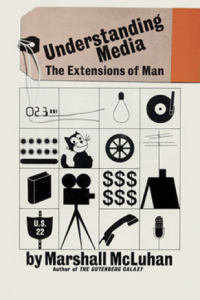
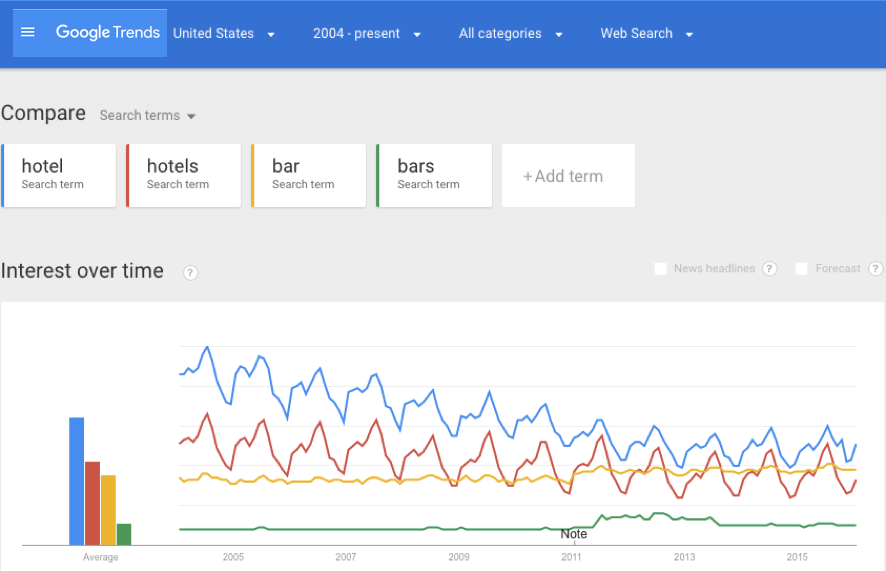
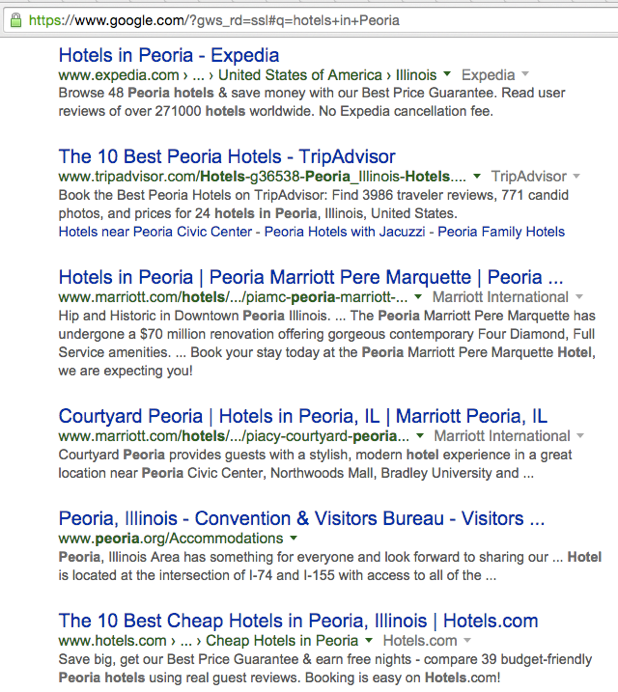
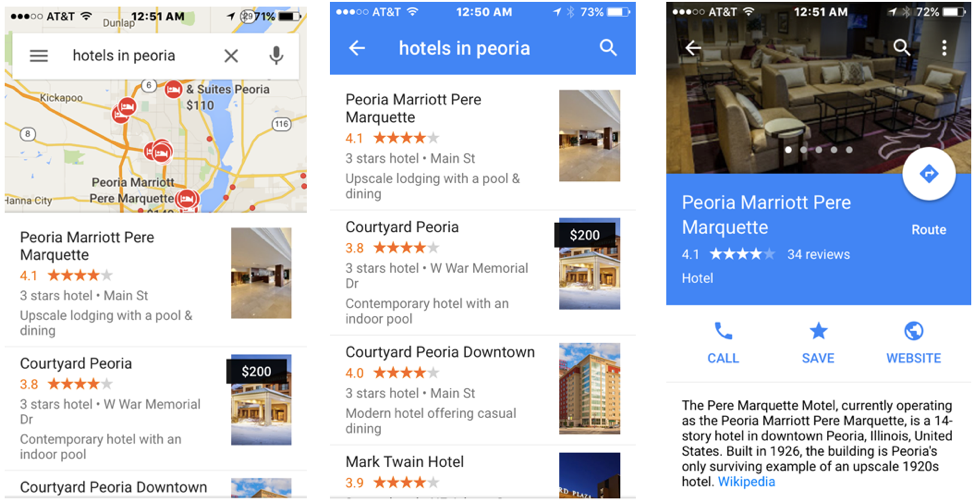
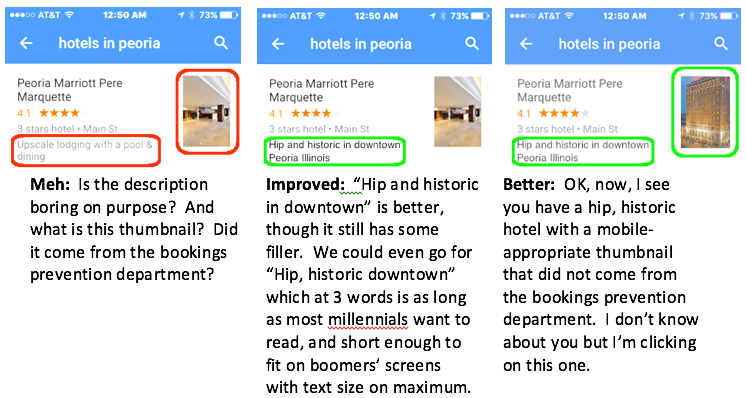
 Previous Post
Previous Post